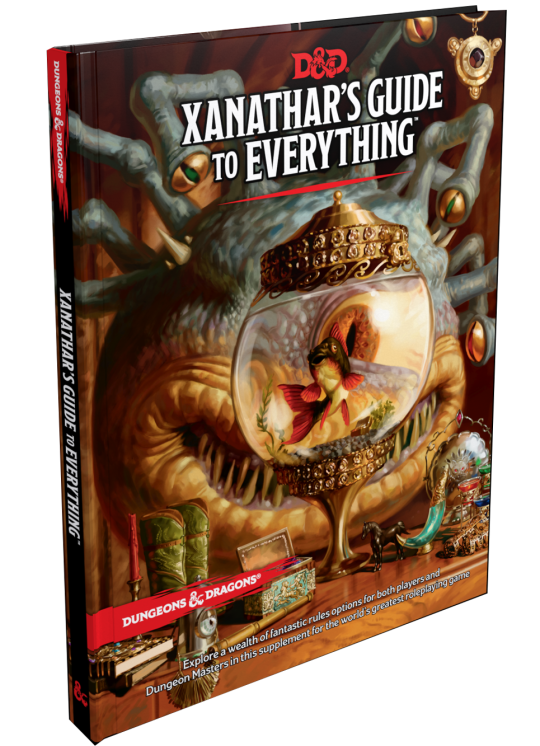The creator of D&D 5th Edition (5e), Wizards of the Coast (Wizards), has published many sourcebooks that serve as rulebooks and reference guides to make the game as fun as possible for players and dungeon masters (DMs) alike. Each of the books adds to the game in many aspects with many emphasising a key element such as character options, monsters or D&D campaign settings.
Here you’ll find an overview of the books that have been published over the years, their purpose, value and what you can expect to find when you crack them open.
The Core Rulebooks
The core rulebooks of D&D 5e are the Player’s Handbook, the Dungeon Master’s Guide, and the Monster Manual. They were all released within a few months of each other in 2014, kicking off the era of 5th edition.
The Player’s Handbook (PHB)
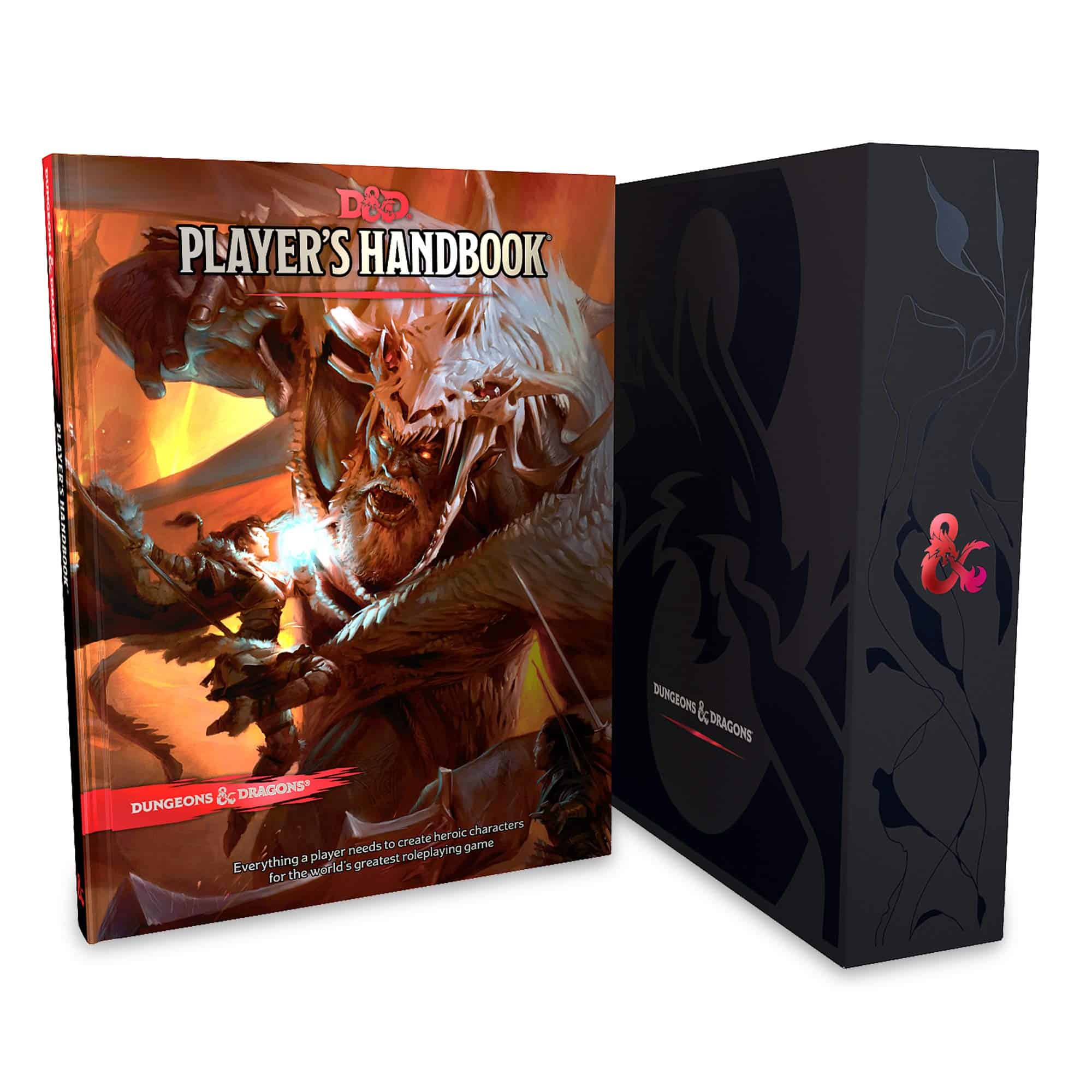
The Player’s Handbook, published August 19th 2014, is the most important resource for any player and an invaluable resource for DMs. If you want to play D&D, this is the book you want. There is a free version of it called the Basic Rules, which is limited to four classes and three races but the PHB contains all the core races, classes and backgrounds in the 5th edition of the game, all of which are needed to create a character.
In Part One, you’ll find all of the information you need to create your own playable character in D&D. You’ll learn how to assign ability scores, pick a race, class and background and what features you can expect to gain as your character levels up.
You’ll also find weapons, armor and adventuring gear tables for all the equipment that your character will have on them. These tables provide crucial information such as the damage a given weapon will do and what armor class your character will have.
Part Two consists of all the core rules for playing the game now that you’ve made your character. You’ve decided your ability scores and now you’ll learn the kinds of things they are used for. In this section are also rules for social interactions, overland travel and the resting mechanics.
A section of the book that you’ll keep opening and referring to as you play the game are the rules for combat found in this part. You’ll learn how actions, bonus actions, reactions, turns, and healing function.
Part Three is all about magic. Eleven out of the twelve original classes can cast spells making it an integral mechanic of the game. In this part, you’ll learn the rules for casting spells, areas of effect, components and the last chapters of the book describe a massive list of 362 spells. Unfortunately, these spells are only listed alphabetically and it can become tedious flipping back and forth. Therefore, it’s common to use spell cards or an app to streamline the process.
Monster Manual (MM)
Originally published September 30th 2014, the Monster Manual is a resource published exclusively for DMs to use. The entire book is a bestiary that supplies DMs with various monsters and enemies that they can populate the game with for their players to encounter.
You can expect to find over 300 monsters in this book from dragons to giants to purple worms. Each of them is given their own statistics (stat block) which determine their bonuses to hit, AC, hit points and special abilities.
More than stat blocks, this book provides extensive lore about most monsters including what environments they can be found, their alignment, and what they might do when the players encounter them.
A game of D&D would be boring if it weren’t for the monsters that populate the world. The MM is the core sourcebook that gives DMs the enemies they need to make an exciting game.
Dungeon Master’s Guide (DMG)

The Dungeon Master’s Guide was published December 9th 2014 and is another resource book designed to be used exclusively by dungeon masters, hence the title. While the PHB covers plenty of rules that you’ll need to have in order to play the game, this book covers the following:
- Creating your own world including pantheons, a multiverse, factions, cities, maps and languages
- Designing adventures including ideas for building encounters, creating non-player characters and treasure and magic items
- Tips for managing the table and additional rules that might come up in your game including roleplaying NPCs in social interactions, statistics for objects, poisons, diseases, madness, and variant rules for combat
This book is the ultimate sourcebook of DMs to learn how to prepare and run a game of D&D. The worldbuilding section will hook many DMs into obsessing over a world of their own creation while the adventuring section gives much needed details about what a session will look like. The extensive list of magic items provides great rewards for players when they slay the monster and DMs will find themselves opening the book mid-session to answer a question the whole table is asking.
Supplemental Rulebooks
From 2016-2020, Wizards has released four supplemental rulebooks with additional races, subclasses, backgrounds and monsters. Two of them are primarily used by dungeon masters for their worldbuilding and monster lore. The other two act primarily as supplements to the PHB for players to choose from new subclasses for their character.
Volo’s Guide to Monsters (VGtM)

VGtM was published November 15th 2016 and adds over 100 new monsters to the game for DMs to use in their games. This book is all about monsters and, in addition to an extensive bestiary, includes a lot of lore about particular types of monsters including beholders, giants, hags and mind flayers.
This book also includes new playable race options for characters such as aasimar, firbolg, goliath, kenku, lizardfolk, tabaxi, and triton. There are also playable monstrous races such as bugbear, goblin, hobgoblin, kobold, orc, and yuan-ti. In the first publication of this book, the kobold and orc traits had negative modifiers to ability scores but has since been removed.
Xanathar’s Guide to Everything (XGtE)
Xanathar’s Guide to Everything was published exactly one year after VGtM on November 15th 2017 and lives up to its name as it contains a lot of new content.
Chapter One provides players with plenty of new character options such as 31 new subclasses, racial feats, and an in-depth look at creating character personalities.
Chapter Two is full of tools for dungeon masters. The first section of this chapter is a reminder of some commonly forgotten rules such as simultaneous effects and damage from falling. From there, you’ll find many topics from the PHB or DMG revisited for players and dungeon masters alike with the intent of clarification and guidance. Such topics are:
- Tying knots
- Tool proficiencies
- Spellcasting including identifying spells and area of effects
- Encounter building
- Traps
- Downtime
- Awarding magic items
The last chapter provides 95 new spells for players to use. Similar to the PHB, these are sorted alphabetically. If you’re using an app or cards for your spells, these spells will most likely be included.
Mordenkainen’s Tome of Foes (MToF)
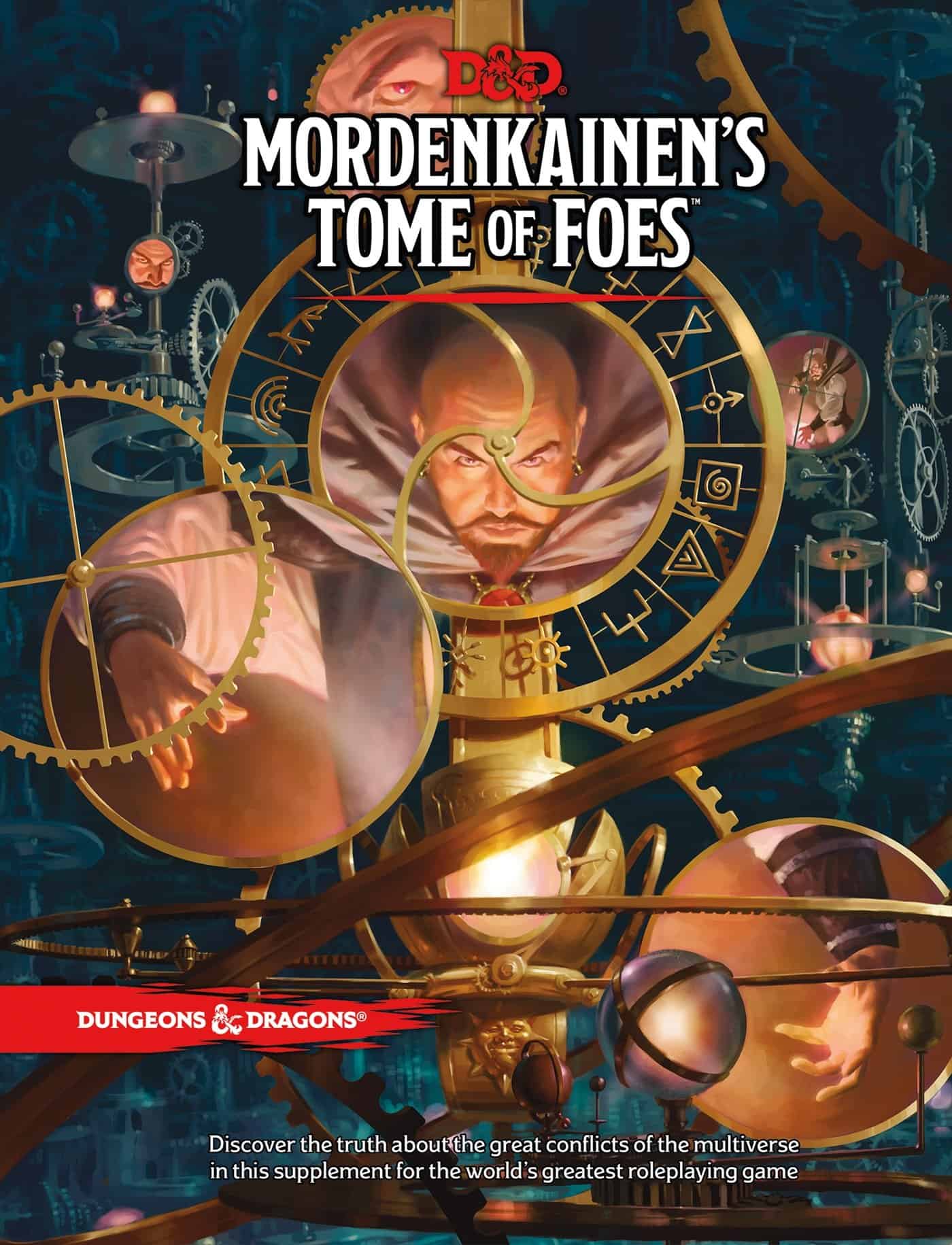
MToF was published May 28th 2018 and is the second supplemental book that focuses more on monsters than on player characters. This book focuses on the epic, ongoing conflicts that exist across the D&D multiverse and gives you inspiration for implementing them in your games.
These conflicts include that between demons and devils, elves and drow, dwarves and duergar, githyanki and githzerai, and halflings and gnomes. Included in these sections are playable race options for new tiefling subraces, eladrin, sea elves, and Shadar-Kai, duergar, gith, and deep gnomes.
The last chapter that occupies half the book is a bestiary with a large focus on many of the key players in the detailed conflicts found in the book such as high-level devils and demons.
Tasha’s Cauldron of Everything (TCoE)
Reminiscent of the earlier Everything supplement, TCoE adds 22 new playable subclasses, new feats, spells, magic items, and dungeon master resources. Published November 17th 2020, this book is a treasure trove for players and dungeon masters alike.
The titular Tasha refers to a famous witch in D&D lore and therefore much of the content in this book favors spellcasting classes and abilities. Despite that, every class gains new subclasses and new optional abilities for all classes including many psionic-themed subclasses. You’ll also find the artificer class republished from the Eberron campaign setting.
This book also contains a lot of optional rules and ideas for character creation including customizing your own race, and changing proficiencies and subclasses.
The second half of this book is filled with dungeon master tools introducing tools such as group patrons, magical environments, followers, session zero, and puzzles to implement in your game.
Campaign Settings
D&D is a flexible game that can take place in any world. Your game of D&D might take place in a world that your DM has created themselves or it might take place in one of the settings created by Wizards of the Coast. Campaign Setting books provide information and outlines for these settings.
A book might add new race options or subclasses that fit the setting. However, many DMs allow any published race in any setting that they’re running. If you’re creating a character for the game, always talk to your DM about your choice before rocking up to the first session.
Sword Coast Adventurer’s Guide (SCAG)
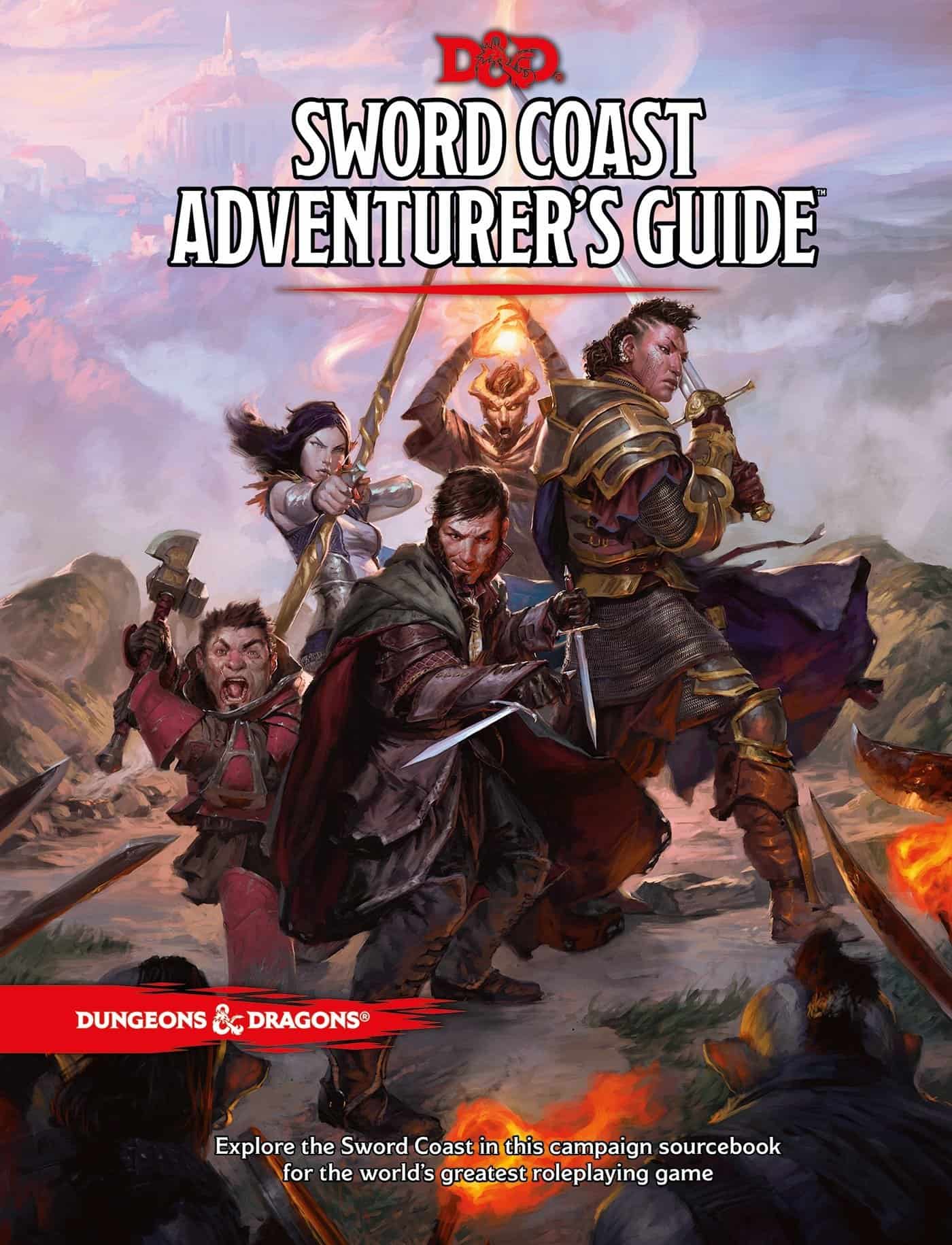
The Sword Coast’s Adventurer’s Guide was published November 3rd 2015, the first after the core rulebooks. The Sword Coast is found on the continent Faerûn in the campaign setting of the Forgotten Realms.
This book primarily contains lore about the setting and inside you’ll find information about the geography, history, magic and the gods of Faerûn. This covers famous D&D cities such as Waterdeep and Baldur’s Gate. All of this is particularly useful if you’re running your game in any part of the Sword Coast.
The last chapter of the book contains a small amount of new races, classes, backgrounds, and spells. However, many of the options were later reprinted in a later supplemental rulebook.
Overall, the general consensus is that this book leaves much to be desired. It is short compared to the other books published by WoTC totalling only 159 pages. A lot of the information about Faerûn can be found on the Forgotten Realms wiki and many of the new player options published in this book are either severely underpowered or have been fixed or republished in future publications such as the Bladesinger in TCoE.
Guildmaster’s Guide to Ravnica (GGtR)
Published on November 20th 2018, this book is all about the city of guilds known as Ravnica. Since it focuses on a single city, a lot of depth is added to the location and gives DMs a lot to work with to set a campaign in Ravnica. There’s even a chapter entirely dedicated to potential adventures related to each of the guilds.
The power of Ravnica lies within ten guilds all dedicated to different goals and means. Not only will you find extensive information about each of these guilds from the law keepers of the Azura Senate to the biological scientists of the Simic Combine, this book also has additional guides for creating your character to fit into Ravnica by choosing a guild according to your values.
You’ll also find more race options such as the centaur, loxodon, minotaur, simic hybrids and vedalken. The last two chapters contain some new magic item options and a compendium of friendly non-player characters and hostile monsters that inhabit the city of guilds.
Acquisitions Incorporated (Acq Inc)
Acquisitions Incorporated was originally the name of a D&D party who ran a business of the same name since the 4th edition of the game. It evolved from a podcast into a Twitch series, comic, PAX live show, and this book published June 18th 2019.
This book seeks to capture the combination of a dark office comedy combined with dungeons and dragons and give you the tools to run games in the same vein. Using this book, your adventuring party can own and run a franchise of the business Acquisitions Incorporated.
You’ll find rules for running and expanding the business, dealing with competitors, company positions that give players new abilities, spells, backgrounds and one new race option: verdan. This book is a great resource and much of the content in this book can be reskinned for DMs to let an adventuring party build up their own stronghold or guild.
Chapter 4 of this book contains a complete Acq Inc adventure for a party that takes them from 1st-7th level with plenty of plot hooks for future adventurers.
Eberron: Rising from the Last War (ERLW)
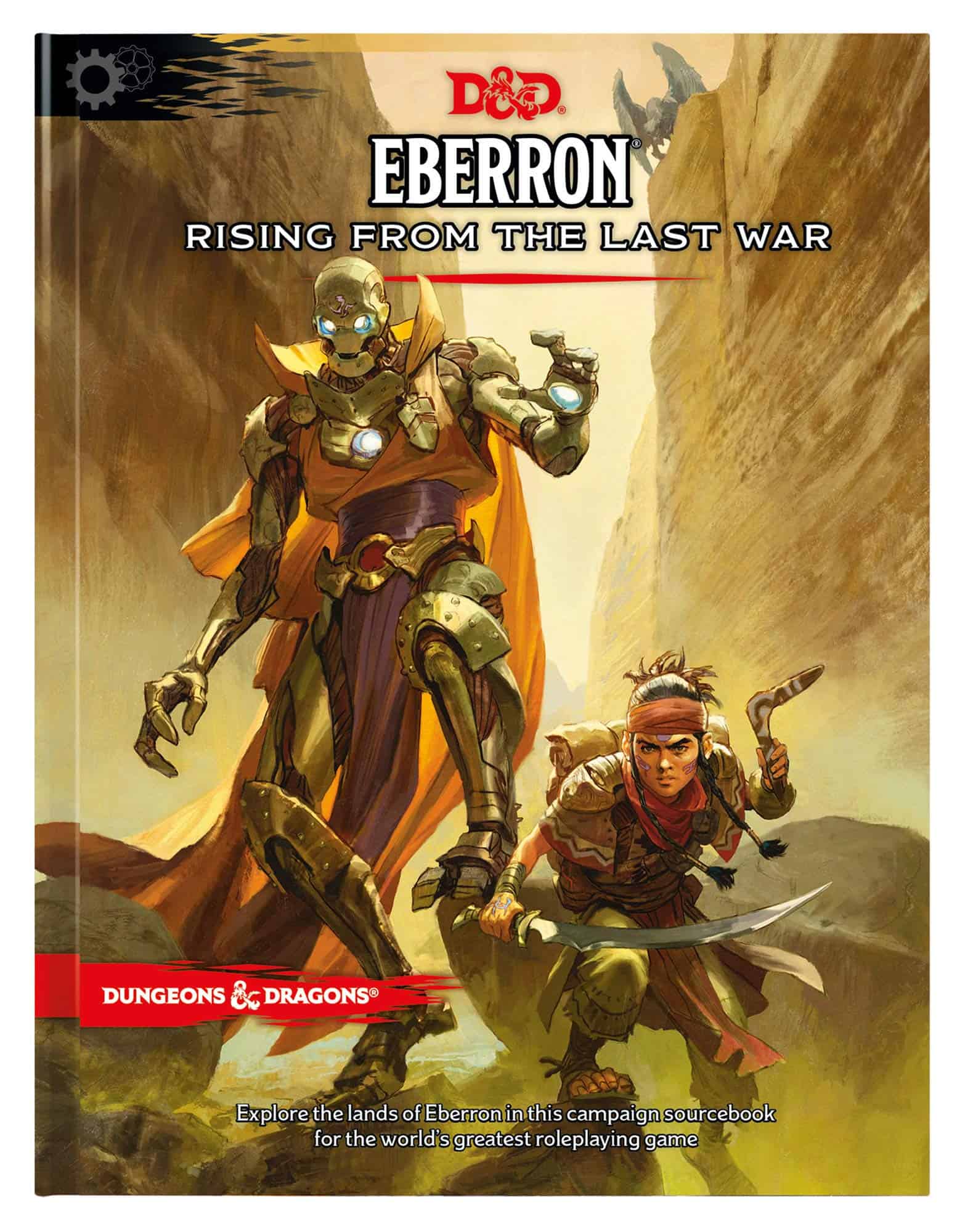
Eberron is a campaign setting introduced in 3rd edition with magic-fueled technology such as lightning rail trains, skyships, and mechanical beings. On July 23rd, 2018, Wizards published the book Wayfinder’s Guide to Eberron. This was a smaller, prototype version of the much larger book ERLW, which was later released on November 19th, 2019.
Chapter 1 contains playable race options to fit the setting such as changelings, kalashtar, shifters, and warforged. This book also introduces dragonmarks to the game. Dragonmarks are ancestral marks inscribed on a body that allow certain inherent abilities. Moreover, in this book, you’ll find the first publication of the new artificer class. The artificer would later be republished with an additional subclass in TCoE.
The next few chapters provide copious detail for the steampunk campaign setting starting with the continent Khorvaire, its nations, and the state of the kingdoms in the aftermath of the last war: a conflict that tore the continent apart and only recently ended with the signing of a treaty. As you explore this world, you’ll discover the many differing attitudes and beliefs in the wake of the war.
This book takes its time detailing the aspects of the world, with an entire chapter dedicated to the city Sharn and another specifically to provide DMs with tools to create adventures in Eberron. This book is one of the largest campaign settings clocking in at 320 pages and brilliantly brings the world of Eberron to 5th edition.
Explorer’s Guide to Wildemount (EGtW)
Fans of the D&D phenomenon Critical Role will immediately recognise Wildemount as the setting of the second campaign traversed by the adventuring party The Mighty Nein. This book, published March 17th 2020, takes a world plagued with war for you to use at your table.
While Eberron is a setting recovering from war, Wildemount has just been plunged into a war between two superpowers and this book gives you the options to set the war as front and centre of your adventures or ignore them entirely.
For players, there are new character race options exclusive to the setting such as the pallid elf, lotusden halfling and the dragonborn variants draconblood and ravenite. Although they can be found in published adventures, EGtW is the first sourcebook after the DMG that provides a new option for supernatural gifts: hollow one. This is a gift that a player could receive that bestows upon them an undead nature.
In addition, you’ll find three new subclasses capable of wielding Dunamis: the magic of Wildemount. These are the fighter subclass Echo Knight, and two wizard subclasses: the schools of choronurgy and graviturgy.
Like the other campaign settings, this book contains plenty of advice about how to run a game in Wildemount and even includes four adventures for a dungeon master to use. Designed to take characters from 1st to 3rd level, any of these adventures is a great starting point for a campaign in Wildemount that a dungeon master can then expand on for an ongoing campaign.
Mythic Odysseys of Theros (MOoT)
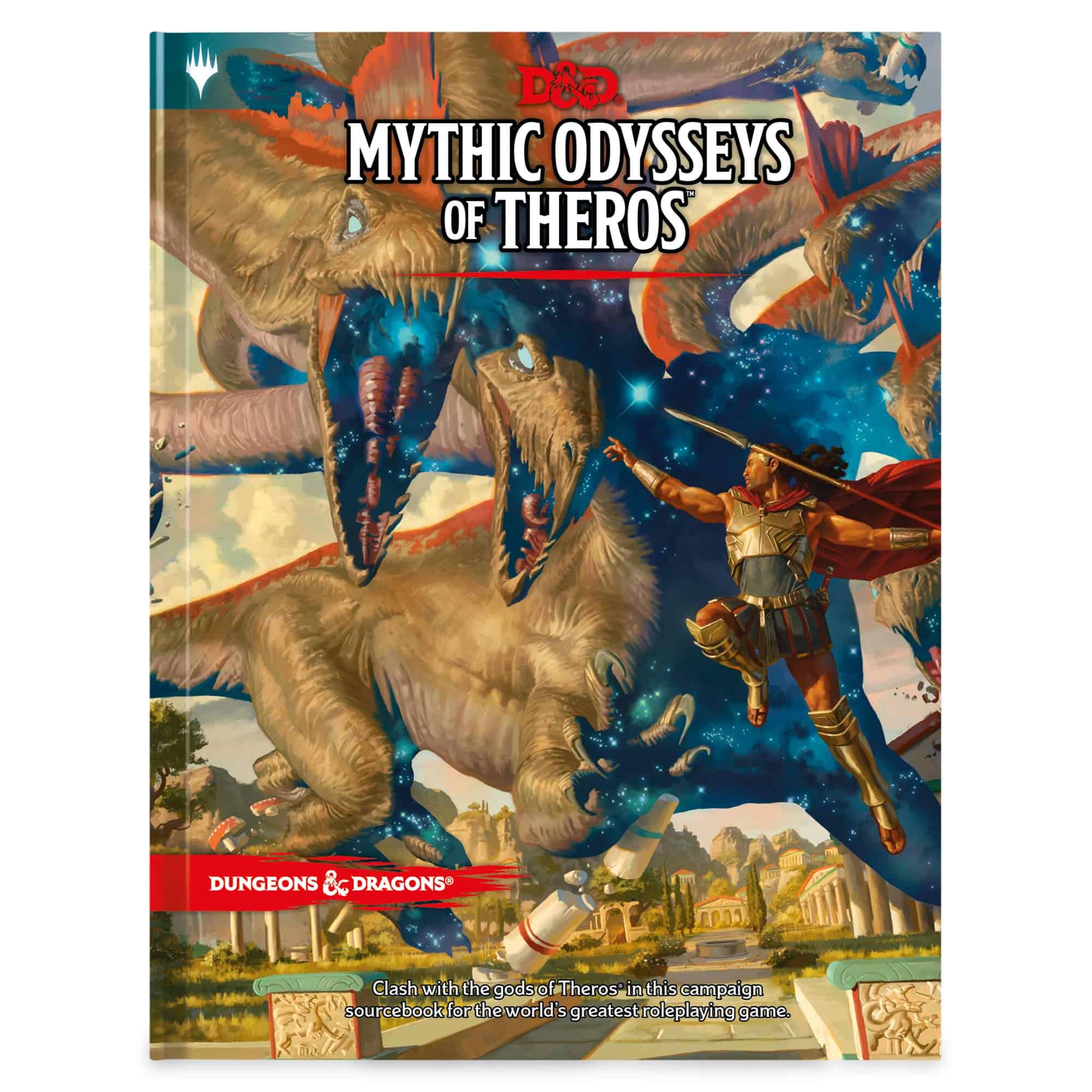
If you’ve ever wanted to play D&D in a world of epic heroes inspired by ancient Greek myths and legends, MOoT is the setting for you. Like Ravnica, Theros is a world originally created for the trading card game Magic: The Gathering.
In this book, published June 2nd 2020, you’ll find new race, class, and background options for players, a pantheon of Greek-inspired gods who use mortals for their own games and power plays, world history, adventure tools for dungeon masters, treasures, and a bestiary full of mythic monsters.
While EGtW provided one new supernatural gift, MOoT explores a world where the gods have champions and many heroes have been blessed with a gift. This book has nine new supernatural gifts and a new piety system that unlocks additional abilities for your character as they remain dedicated to their deity.
The two new race options are the Leonin and Satyr and the two new subclasses are the bard’s College of Eloquence and the paladin’s Oath of Glory. The second half of this book contains advice for dungeon masters to build god-based adventures in Theros and even how to make a deity a villain in your campaign.
Overall, this setting introduces an epic tone to the game and is a great option for players who want to feel like a mythic hero like Achilles and Odysseus.
Van Richten’s Guide to Ravenloft (VRGtR)
Ravenloft is one of the original settings of D&D, dating back to an adventure of the same name published in 1983. A small but infamous domain of Ravenloft, Barovia, had been used as the setting for the 5th edition adventure The Curse of Strahd. VRGtR, published May 18th 2021, brings the entirety of the horror themed campaign setting to the 5th edition.
Ravenloft consists of many different domains known as Domains of Dread. Strahd’s Barovia is one such domain but VRGtR provides a total of 39 Domains of Dread as well as tools for dungeon masters to create their own.
VRGtR gives you three new horror-themed lineage options: dhampir, hexblood and reborn. These lineages function similarly to race options, but allow players to create more unique characters. There are two new subclasses: the bard’s College of Spirits and the warlock’s Undead Patron.
Similar to supernatural gifts, VRGtR includes new gifts called Dark Gifts. While allowing players to access new abilities, Dark Gifts may have a deadly cost to use. They might be necessary when encountering the horror-themed monsters found in the bestiary of this book such as the terrifying bagman.
Given the horror-themed setting of Ravenloft, this book also includes many safety tips for players and dungeon masters to use at your table. These guide players on how to approach boundaries, trigger warnings and establish the lines of communication for players feeling uncomfortable at the table. Although only published in VRGtR, these rules are applicable to all tables to ensure maximum enjoyment for players.
Additional Sourcebooks
Since 5th edition’s inception, Wizards has released a few additional supplements for the game.
Sage Advice Compendium
D&D has a lot of rules. The Sage Advice Compendium is a collection of F.A.Q. about certain mechanics of the game. If you read something in the PHB or other sourcebook and you’re still unsure, have a look in this free pdf found on the Wizards of the Coast website as it is constantly being updated.
Elemental Evil Player’s Companion (EEPC)
Another free pdf, EEPC was published April 16th 2015 as a companion to the adventure book Princes of the Apocalypse. This book contains four race options and 43 spells. However, since its publication the race options have all been republished: aarakocra and genasi in EGtW, deep gnomes in MToF, and goliath in VGtM. Similarly, the spells were all republished in XGtE.
The Tortle Package (TP)
While EEPC was a supplement for Princes of the Apocalypse, The Tortle Package, published September 15th 2017, is a supplement for the adventure Tomb of Annihilation. The book includes the tortle race option, which was republished in EGtW, details about the island called the Snout of Omgar, and an adventure location: Dangwaru, the Typhoon Palace.
Related reads: DnD Tortle Guide.
F.A.Q.
Question: What are the D&D Sourcebooks?
Answer:
• Player’s Handbook
• Monster Manual
•Dungeon Master’s Guide
• Volo’s Guide to Monsters
• Xanathar’s Guide to Everything
• Mordenkainen’s Tome of Foes
• Tasha’s Cauldron of Everything
• Sword Coast Adventurer’s Guide
• Guildmaster’s Guide to Ravnica
• Acquisitions Incorporated
• Eberron: Rising from the Last War
• Explorer’s Guide to Wildemount
• Mythic Odysseys of Theros
• Van Richten’s Guide to Ravenloft
• Elemental Evil Player’s Compendium
• Tortle Package
Question: Will there be a 6th Edition of D&D?
Answer: Yes. D&D has existed in multiple iterations since its inception and there will be a new edition at some point. While no official announcement has been made, it is speculated to be coming in the next three years.
Question: Which D&D Sourcebooks should I buy?
Answer: If you want to play D&D, the Player’s Handbook is a must. For additional options, buy Xanathar’s Guide to Everything and Tasha’s Cauldron of Everything.
For DMs, you’ll need the core rulebooks: the Player’s Handbook, Monster Manual, and Dungeon Master’s Guide. The supplements give you more tools and options and if you want to run a game in a particular setting, you’ll want to buy the book for it. There’s no limit for dungeon masters and you can easily buy them all and use them.
Question: Is the Player’s Handbook free?
Answer: The Player’s Handbook costs $49.95. However, there is a free version called the Basic Rules.
Question: How do you become a dungeon master?
Answer: The easiest way to start as a dungeon master is to start with the D&D Starter Set and run the adventure Lost Mines of Phandelver. It’s an interesting adventure that comes with ready-to-go character sheets and coaches you how to run the game.
Summary
Wizards of the Coast has published many sourcebooks for the 5th edition of D&D. The core three rulebooks provide all the necessary tools in order to play a great game but the game continues to stay fresh and exciting for the millions of players with additional character options, monster lore and intriguing campaign settings.
Continue reading: A List of the Best DnD Inspired Books.
- Armor of Agathys 5e Guide: What is Armor of Agathys? - August 3, 2022
- Oath of the Ancients 5e Guide - August 3, 2022
- Dissonant Whispers 5e Guide - July 20, 2022

